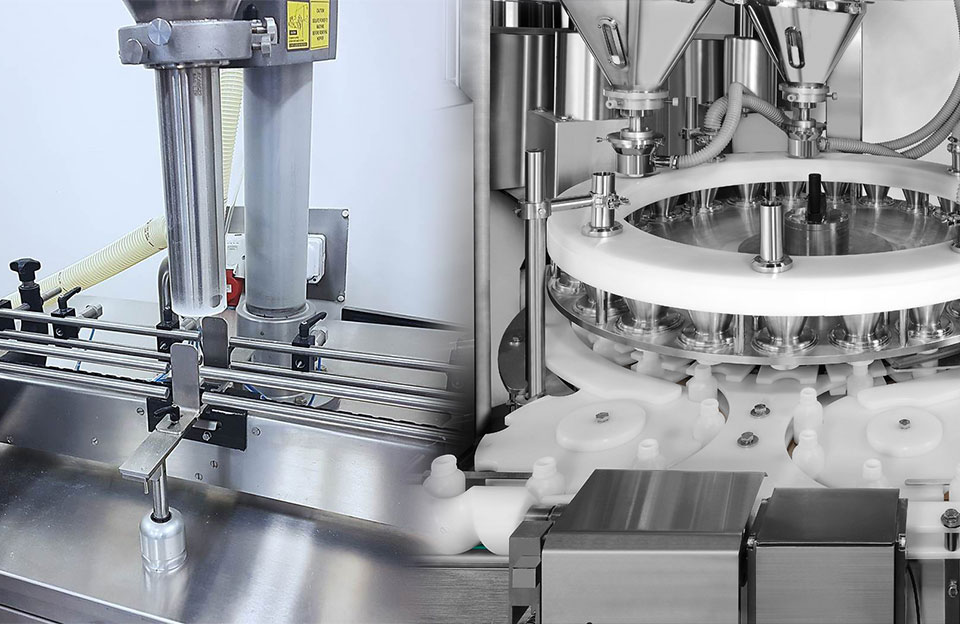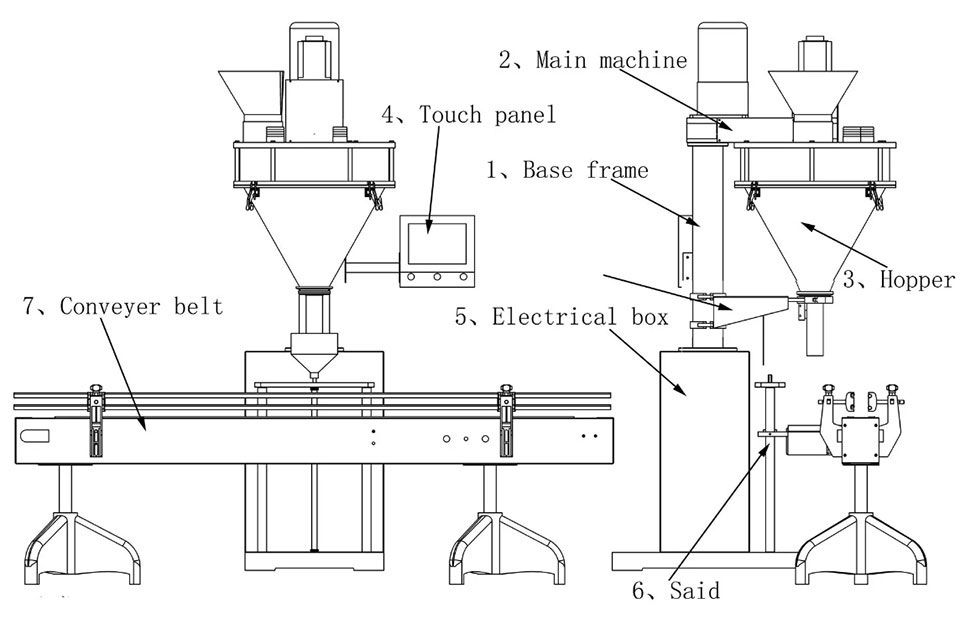Linear and rotary powder filling machines are two different modes of powder filling. According to the specific needs of the production process, both linear and rotary powder filling machines have their advantages.
Linear machines are known for their versatility, flexibility, and precise filling measurements. Rotary machines excel in high-speed filling applications and are suitable for high-volume industries. They are typically used in industries that require efficient and precise filling of powdered products into containers. These machines automate the filling process, increasing productivity and reducing manual labor.
A General Comparison Between Linear and Rotary Powder Filling Machines
Linear and rotary modes are typical powder filling machines used in various industries. Here’s a general comparison between the linear and rotary powder filling machines:
Operation:
- Linear Mode: In a linear powder filling machine, the containers move in a straight line along a conveyor belt or track. The powder is dispensed into the containers through the filling place.
- Rotary Mode: The containers are loaded onto a rotating turntable or carousel in a rotary powder filling machine. The turntable moves the containers from one station to another, dispensing the powder into them.
Speed and Efficiency:
- Linear Mode: Linear filling machines are generally suitable for moderate to high-speed filling operations. They can handle many containers per minute, making them efficient for high-volume production.
- Rotary Mode: Rotary filling machines are designed for high-speed filling applications. The continuous rotary motion allows for faster filling rates compared to linear machines. They are ideal for industries requiring high production rates.
Flexibility:
- Linear Mode: Linear filling machines are typically more versatile and flexible when handling different container sizes and shapes. They can easily accommodate various container dimensions by adjusting the conveyor system.
- Rotary Mode: Rotary filling machines often specialize in specific container sizes and shapes. Switching between different container formats may require more significant adjustments or even a changeover of machine parts.
Accuracy and Precision:
- Linear Mode: Linear filling machines can provide precise and accurate filling measurements, especially for smaller containers. The linear movement allows for better control over the filling process.
- Rotary Mode: Rotary filling machines can also achieve high accuracy and precision, but they may have slight variations due to rotary motion. However, advancements in technology have minimized such variations in modern rotary machines.
Footprint and Space Requirements:
- Linear Mode: Linear filling machines typically have a more extended footprint due to the linear conveyor system. They require a straight line or U-shaped layout for the filling process.
- Rotary Mode: Rotary filling machines generally have a smaller footprint, utilizing a compact turntable or carousel design. They are suitable for space-constrained production environments.
Maintenance and Cleaning:
- Linear Mode: Linear filling machines are relatively easier to clean and maintain. They have fewer moving parts, and accessing the components for cleaning or maintenance is usually more straightforward.
- Rotary Mode: Rotary filling machines may have more complex mechanisms due to the rotating turntable. Maintenance and cleaning can be more involved, requiring proper disassembly and reassembly of components.
Which One Is the Best? Linear or Rotary Powder Filling Machines?
Choosing a powder filler in linear and rotary powder filling machines depends on a variety of factors, and both linear and rotary powder filling machines have their own advantages and concerns.
Advantages of Linear Powder Filling Machine:
-
- Precise Filling: Linear machines can provide high filling accuracy, especially for small containers or when handling fine powders.
- Versatility: Linear machines can handle containers of various shapes and sizes, making them suitable for different packaging needs.
- Ease of Maintenance: Due to their more straightforward design and fewer moving parts, linear machines are easier to maintain and clean.
Concerns of Linear Powder Filling Machine:
- Speed: Filling speeds may be lower on linear machines compared to rotary machines. However, this depends on the specific model and the throughput required by the application.
- Larger-scale applications: For high-volume production lines, linear machines may not be as efficient as rotary machines due to potentially slower speeds.
Advantages of Rotary Powder Filling Machine:
- High Speed: Rotary machines are known for their high-speed filling capabilities, making them suitable for large production lines.
- Efficiency: With multiple stations, rotary machines can perform various operations simultaneously, increasing overall efficiency.
- Automation Integration: Rotary machines can be easily integrated into automated production lines to synchronize with other equipment seamlessly.
Concerns of Rotary Powder Filling Machine
- Filling accuracy: While rotary machines can achieve good filling accuracy, they may not be as precise as linear machines when small containers or fine powders are involved.
- Complexity: Rotating machinery designs are more complex and have more moving parts, which increases maintenance requirements and costs.
Conclusion
Linear and rotary mode powder filling machines are both excellent fillers. The choice between the two depends on factors such as production volume, container flexibility, available space, and desired accuracy. By selecting the most appropriate type of powder filling machine, enterprises can optimize the filling operations and enhance overall efficiency.


